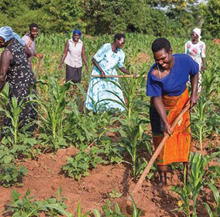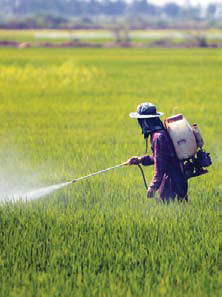Farm Management: Controlling Input Costs
Almost everything we buy today is affected by rising prices. Many of them we can do nothing about, but the question we must ask ourselves is, “What can I do on my farm to control increasing costs?”
 Input (production) costs are a fact of life for every farmer, so the best course of action is to see what can be done to minimise their impact on your farming operations and ultimately on the bottom line (profits).
Input (production) costs are a fact of life for every farmer, so the best course of action is to see what can be done to minimise their impact on your farming operations and ultimately on the bottom line (profits).
In this article I’ve divided input costs into 2 sections:
- Costs you cannot control.
- Costs you can control.
Every farm will have its own challenges and ways to handle them, but a few general pointers should also help.
Under the heading of “fuel”, I talk about servicing and maintenance. A good operator on the right machine, that is well-maintained and serviced, doing the right job, is an investment. The opposite to that is, of course, a cost.
COSTS YOU CANNOT CONTROL
You can do nothing about the price of fuel, electricity, fertiliser, equipment and so on, but you can take steps to help minimise the effect of these input costs on the overall production costs of your farm.
The key is to accept that they are a part of your farming life, so let’s see what can be done to reduce their impact on your farming operations. We’ll take 2 of your major costs – fuel and fertiliser – and see what can be done to reduce their negative impact.
Fuel
Plan travel more carefully, and try to combine trips where possible.
Check that:
- Engines are properly tuned and not burning extra fuel.
- Diesel injectors are tested, cleaned and set for optimum operation.
- Filters are checked and cleaned regularly.
- Vehicles, tractors and equipment are serviced, maintained and kept clean for maximum efficiency.
- Every driver has been trained to drive responsibly to save fuel, and is encouraged to do so; perhaps by a bonus incentive system based on fuel saved and/or repair costs reduced.
- See what discounts/payment terms you can arrange if you buy fuel in bulk.
Fertiliser
 If you have not already done so, now is the time to change your thinking from feeding the plant to feeding the soil first. It is fundamental for a good farmer to get the correct nutrient balances in the soil for the roots to take up what is needed and thus feed the plant. Rather spend more money on good manure/compost or plant cover crops that will nourish the soil than on expensive fertiliser.
If you have not already done so, now is the time to change your thinking from feeding the plant to feeding the soil first. It is fundamental for a good farmer to get the correct nutrient balances in the soil for the roots to take up what is needed and thus feed the plant. Rather spend more money on good manure/compost or plant cover crops that will nourish the soil than on expensive fertiliser.
Have you had a reliable soil analysis done? Soil analysis done by a reputable firm will be the foundation for your plant-feeding programme; make sure it is the best. You don’t want to waste fertiliser on over-application.
- If you have to use fertiliser, consider using organic fertilisers and, if you can afford it, try to buy stocks in advance to get the best prices.
- Make sure fertiliser bags are handled and stored properly to avoid breakages and wastage. Every grain of fertiliser costs money!
- Check that your fertiliser spreader and other equipment are set correctly and operate as they should.
- If you are applying fertiliser by hand, make sure the people concerned are trained to spread the fertiliser properly and carefully.
- Are application rates correct? Too much wastes money; too little, the crop suffers.
COSTS YOU CAN CONTROL
Some costs are easier to control than others. Start with your expenditure budget and look at farm expenses since the start of the financial year. Remember, you’ll have a record of what you expected to spend and what you actually spent.
This is one of those times when you’ll be glad you kept up with your admin work, because now you need information to help make important decisions. Identify the costs that have gone over budget and write down the serious ones that took a really big bite out of your original budget.
With your list of serious budget increases in front of you, go through each one carefully and see why it was so far over budget. That will help you to decide if you can do something about it or not.
Fuel and fertiliser will be 2 of them and we’ve already discussed a few ideas on how to handle them. In business, some of the other costs which tend to get out of control are labour and machinery repairs.
Labour
If you employ only 2 or 3 people, this cost should not be too high, but if you have 10 or more people working for you, it becomes a very important farming expense.
Everybody has to pay staff according to the law so I’m not going to cover that here. I am concerned about how your staff is being used and the ability of each person to do his/her job effectively. These are areas where you can lose a lot of money through downtime and inefficiency. Take a close look at each person and consider the following:
- Is he/she the right person for the job?
- Is he/she properly trained to do the work?
- How is he/she doing the job?
- What can be done to do it better, faster and more cost-effectively?
- Do you need more or fewer people to do the job?
- How much time does he/she spend away from the job during working hours – downtime?
- How often is he/she off work and for what reasons?
- What about the whole pay “package”? Is he/ she being paid a fair wage? What about other benefits?
- How motivated is the person and what is his or her attitude towards the job and fellow workers?
- And now for the big one which very few people ask themselves: How am I (or a supervisor) managing this person?
Improving worker performance is critical to any business because you are dealing with human beings, and that adds many other factors to the issue which you do not have with other farming activities. You can save money and increase profits through good people management.
Machinery And Equipment
Any machine, tractor, bakkie or vehicle costs you money – whether you use it or not. So, it is crucial to know your costs and identify areas where you can save. Consider the following:
- Am I using my equipment effectively? In other words, is the equipment being used for the intended purpose, and is it performing as required?
- Is that tractor too big for the job, or too small? If it’s too big I’m wasting money. If it’s too small it will cost more to do a job and will be more likely to break down.
- What are the repair costs on this machine? If they are too high, I must find out why and take action to reduce them.
- Is the operator doing his job properly? Is he/ she trained to do the job? Is he/she adding to repair costs or helping to keep them down?
- Do I have too much equipment on the farm? Perhaps I have machines that are not being used effectively so I could sell them and bring in some extra cash. Many farmers don’t like to do this because they think they might need the machine again “one day”, or it would be useful for spares. In most cases it ends up being a piece of junk and makes the farm look like a scrapyard.
Through good planning and management you can use farm equipment more effectively, thereby improving outputs and reducing costs.